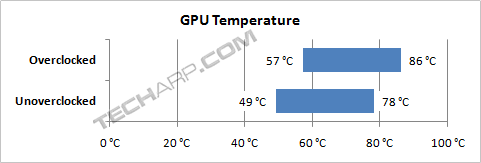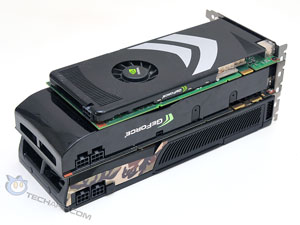Size Comparison
The NVIDIA GeForce 9800 GTX+ is the same size as the GeForce 9800 GTX. Here, we compare the size of the GeForce 9800 GTX+ with the new GTX 260 (bottom) and GeForce 8800 GT (top).
 |
As you can see, the GeForce 9800 GTX+ is as big a card as the new GTX 260. It is certainly much larger than the lean and mean GeForce 8800 GT.
Cooler GPU?
Theoretically, the smaller 55 nm process technology used to fabricate the GeForce 9800 GTX+'s G92 GPU should allow it to run cooler and with a lower power consumption. However, there have been assertions that the GeForce 9800 GTX+ actually uses more power. Unfortunately, we are not able to test that out for ourselves, so we examined the GPU temperature instead.
To get a better idea of the kinds of GPU temperatures the GeForce 9800 GTX+ has, we tested it at both stock and overclocked (815 MHz core, 1320 MHz memory) clock speeds, and with the fan set to 0% and 100%. Let's take a look at the results :

Obviously, the lower temperatures are when the fan was turned all the way up to 100%. It was quite loud, of course, but that sure kept the GPU temperature low, even when overclocked. Surprisingly, we discovered (accidentally!) that the GeForce 9800 GTX+ was able to run a 3D game like Unreal Tournament 3 with its fan set to 0%. No, the fan was not turned off but it was running at its absolute minimum speed and whisper-quiet.
We then tried running Unreal Tournament with the card overclocked to 815 MHz core and 1320 MHz memory. This time, Unreal Tournament 3 would hang after some time, but only if the fan was forced to 0%. It had no problem running at those clock speeds if the fan was left at Auto or something higher like 20%. That is certainly not possible with the older 65 nm G92 (as used in the GeForce 8800 GTS 512MB).
Specifications
Core / Card Code Name |
• G92 (D8E) |
Manufacturing Process |
• 0.055 Micron (55 Nanometers) |
Transistor Count |
• 754 Million |
DirectX Support |
• 10 |
Interface |
• PCI Express 2.0 |
Stream Processors |
• 128 |
Vertex Shader Version |
• 4.0 |
Pixel Shader Version |
• 4.0 |
Textures Per Clock |
• Average 64 |
ROPs |
• 16 |
Core Clock Speed |
• 738 MHz |
Shader Clock Speed |
• 1836 MHz |
Fill Rate |
• 47232 MTexels/s |
Memory Bus Width |
• 256-bits |
Memory Size |
• 512 MB |
Memory Type |
• GDDR3 |
Memory Speed |
• 1100 MHz (2.2 GHz DDR) |
Memory Bandwidth |
• 70.4 GB/s |
RAMDAC |
• 400 MHz |
Display Support |
• Two dual-linked HDCP-enabled DVI-I outputs |
Support Tech ARP!
If you like our work, you can help support out work by visiting our sponsors, participate in the Tech ARP Forums, or even donate to our fund. Any help you can render is greatly appreciated!
<<< The NVIDIA GeForce 9800 GTX+ : Previous Page | Next Page : Dismantling The Card, Graphics Memory >>>







 Add to Reddit
Add to Reddit

